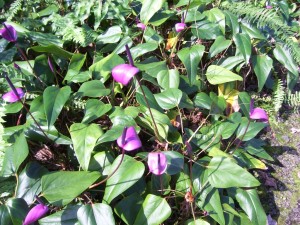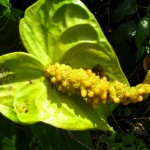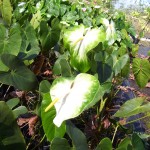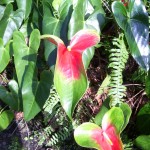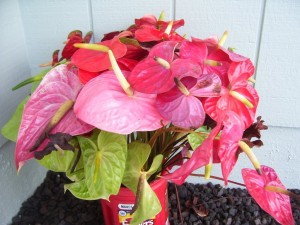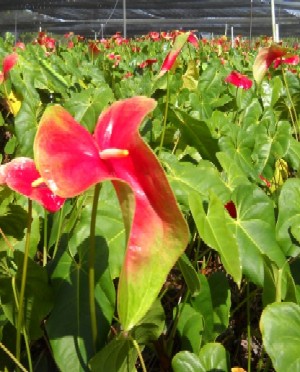Anthuriums
The genus Anthurium is a member of the family Araceae and may consist of up to 1,000 species. Since the members of this genus grow in the Amazon rainforest, which has yet to be fully explored, many new species continue to be discovered each year. Some people mistakenly believe that this genus is also native to Asia, but plants found there appear to have been introduced by humans.
Members of this genus grow in tropical rain forests that receive abundant rain fall. They can be found growing on the ground or on trees. They can grow in many forms, but the most prevalent forms are bushes or vines, attached to trees. They can grow from seeds or as offshoots of parent plants. Offshoots are genetically identical to parent plants, while seeds, even if produced by self-pollination may not be exactly identical to their parent.
All members of Araceae produce an inflorescence or spadix, where both male and female portions of the flower are present. Self pollination does not occur, unless a plant produces multiple flowers at different times because the stigma and the stamen are active at different times. The spadix is surrounded by a spathe, a modified leaf, which is mistakenly thought to be the flower by some, whereas the spadix is the true flower of the anthurium.
Anthuriums may be grown for their leaves or for their flowers. They can be grown outdoors in tropical climates or indoors in colder climates. Warmer temperatures, 65 to 80 degrees, are required, and freezing temperatures will damage these plants. They grow well in moist, but not saturated soil, with a lot of humus. Direct sunlight will harm them, so keep them in bright indirect light.
They are most commonly propagated by taking cuttings. A cutting should have at least two growing nodes that consist of bunches of roots and leaves. It should be placed in a mix of peat moss and perlite or sand and watered regularly. They may also be propagated by seed, but the production of seed will often require an expert’s skill and patience; since the process from pollination to seedling may take up to a year and a half.
Obake Anthurium Flowers
In Japanese, the word obake means “a thing that changes” and it can also be translated as “ghost”. Obake anthurium flowers (which are sometimes miss-spelled obaki) could easily have received their name from either translation. They usually come in a mix of colors, so it is easy to see that their coloration could be “a thing that changes.” In addition, they are large flowers with a wavy surface, which gives them an otherworldly or ghostly feel. Here are some of my favorite types of obake anthuriums.
Tropic Sunrise
Tropic Sunrise is a very popular orange obake anthurium. It is a large flower with an orange center, surrounded by green edges, which was developed by the University of Hawaii. H. Kanemoto created it by crossing an Anuenue with a Soga Orange Obake back in 1981.
Mauna Loa
Mauna Loa is a stunning white obake anthurium flower. It possesses a white core with a green perimeter. Mauna Loa was created from an open pollinated Tropic Ice, which means that we don’t know which variety supplied the pollen to produce this strain. In addition, it has an outstanding 56 day vase life if placed in water immediately after harvest.
Other beautiful white obake varieties include Tropic Ice, Pearl and Rainbow Obake. The Rainbow Obake is particularly beautiful, because instead of having only two colors, it has three colors. It is white in the center, has green edges and it has pink veins. Pink obake varieties include the Anuenue Obake, Kimi Obake and Watermelo Obake.
Red Obake Varieties
There are a number of red obake varieties, most have a red core surrounded by green edges. They include the Kalapana Obake, Charade Obake, Madame Pele and the Oshiro Red Obake. The Kalapana is named after a region in Hawaii that was known for having a beautiful black sand beach that was covered by a lava flow from Kilauea Volcano, which according to Hawaiian legends is the home of volcano goddess Pele, whom the Madame Pele Obake is named after.
Buying Obake Anthuriums
When you are looking to buy flowers or obake anthurium plants be prepared to pay more. These flowers are much larger and much showier than standard varieties and they are also much rarer, so naturally they are going to cost more. So if they are more expensive, don’t be alarmed. However, you will get good value for you money as these flowers look amazing and come in some very special color combinations.
If you plan on buying obake plants, just make sure you know what you are doing when it comes to anthurium care. Obake anthuriums are harder to grow than other varieties. Their large flowers and leaves make them more vulnerable to pests, diseases and the elements.
Tips For When You Buy Anthurium Flowers
When ordering anthurium flowers, there are a few things that you should know. The difference between knowing and not knowing these things can be the difference between being happy or being unhappy with your purchase.
Firstly, the number one rule is to know exactly what you are ordering. Just about all websites will show you pictures of beautiful anthurium bouquets, whether they are selling bouquets or loose flowers. But if you unknowingly order loose flowers and are expecting a bouquet you will be sorely disappointed. The key here is to read the details on what you are ordering and to ask if the description is unclear.
If you are ordering a bouquet, you can skip over the tips that follow. But if you are ordering loose anthurium flowers, read on.
If you live in a region that gets cold during the winter, be very careful when ordering at this time. Anthurium flowers are extremely sensitive to frost and can be damaged by exposure to cold temperatures when in transit. So, if at all possible, order during a warmer time of the year. Or if you simply have to order during the wintertime, choose the fastest shipping option available and request that they be shipped in an insulated box. And be sure that you are home to receive them immediately upon delivery, as they don’t take well to sitting on a freezing door step.
To get the freshest flowers and best selection, only buy when they are plentiful. Anthurium plants are most productive during the spring and summer growing seasons. If you order during these times there is often an excess supply of flowers and this will ensure that you get the best flowers. If you order during the winter, when flowers are scarce, you may end up getting leftovers. Keep in mind that winter and summer are reversed in the northern and southern hemispheres. So Costa Rica’s summer occurs during December, while Hawaii’s summer occurs during June.
Finally, when your order arrives, unpack your flowers immediately. Clip a half an inch of the bottom of their stems and place them in water right away. Clipping their stems is absolutely vital; since, your flowers will be in a dry box during transit the pores in the bottom of their stems close up as they dry out. If you were to place them in water without trimming them, they will remain closed, and not absorb water.
Celebrating Christmas in Hawaii
Like in so many other parts of the world, Christmas is a special time in Hawaii. Some aspects of Christmas are the same, like families gathering to spend time with each other and the giving of gifts. But other aspects are different due to Hawaii’s unique mix of cultures and warm climate.
The first thing you’ll notice is that Hawaii doesn’t snow at Christmas time, because the temperature seldom dips below seventy degrees, so Hawaii doesn’t have a “White Christmas.” So instead of snowball fights and sledding, families may choose to spend a sunny Hawaiian Christmas Day at the beach, wearing shorts and bikinis, and santa hats, instead of overcoats.
Christmas trees are much more expensive than in other parts of the world, because they have to be shipped across a large ocean to get here. Some families compensate by growing their own Christmas trees in their backyards. While, others substitute coconut trees or palm trees for traditional Christmas trees. But in any case they are still decorated with bright lights and ornaments.
Often families will celebrate with a luau rather and a roasted pig, rather than a Christmas Ham. The luau will be filled with tropical flowers like anthuriums, heliconias and ginger, rather than mistletoe and holly. When Santa and the Elves arrive they will often be sporting shorts and aloha shirts, instead of thick winter coats. Traditional and Hawaii Christmas carols may be sung, and they’ll often be accompanied by an ukulele instead of the more traditional instruments.
In summary, Christmas in Hawaii combines the foods and traditions of Hawaii’s numerous ethnic groups and is shaped by Hawaii’s unique climate. So don’t be surprised if you find a little bit of everything here. And remember to say “Mele Kalikimaka” which is Hawaiian for “Merry Christmas” when you are visiting.
Disclosure
This website may contain affiliate links. If you have any questions, please find my contact information in the “Contact” page of this website.
I may receive compensation for providing opinions on products, services, websites and various other topics in the form of a commission whenever a visitor clicks on an affiliate link.
Even though I may receive compensation, I always try to provide my honest opinions, findings, beliefs, or experiences here.
The view and opinions expressed in this blog are my own. Any product claim, statistic, quote or other representation about a product or service should be verified with the manufacturer, provider or party in question.
Privacy Policy
Your Privacy
Your privacy is important to us. To better protect your privacy we provide this notice explaining our online information practices and the choices you can make about the way your information is collected and used. To make this notice easy to find, we make it available on our homepage and at every point where personally identifiable information may be requested.
Google, as a third party advertisement vendor, uses cookies to serve ads on this site. The use of DART cookies by Google enables them to serve adverts to visitors that are based on their visits to this website as well as other sites on the internet.
To opt out of the DART cookies you may visit the Google ad and content network privacy policy at the following url http://www.google.com/privacy_ads.html Tracking of users through the DART cookie mechanisms are subject to Google’s own privacy policies.
Other Third Party ad servers or ad networks may also use cookies to track users activities on this website to measure advertisement effectiveness and other reasons that will be provided in their own privacy policies, Anthurium Hawaii has no access or control over these cookies that may be used by third party advertisers.
Collection of Personal InformationWhen visiting Anthurium Hawaii, the IP address used to access the site will be logged along with the dates and times of access. This information is purely used to analyze trends, administer the site, track users movement and gather broad demographic information for internal use. Most importantly, any recorded IP addresses are not linked to personally identifiable information. Links to third party Websites
We have included links on this site for your use and reference. We are not responsible for the privacy policies on these websites. You should be aware that the privacy policies of these sites may differ from our own. Changes to this Privacy Statement
The contents of this statement may be altered at any time, at our discretion.
If you have any questions regarding the privacy policy of Anthurium Hawaii then you may contact us by using our contact form
Tropical Topics
One of our articles on tulip anthuriums was recently featured in Tropical Topics magazine. Tropical Topics is published by The International Tropical Foliage & Garden Society which is located in Australia.
To view this article, here is a link to the excerpt from their magazine: tropical-topics-excerpt.pdf
If you would like to learn more about Tropical Topics magazine or The International Tropical Foliage & Garden Society, here is a link to their website: http://www.itfgs.org/
Types of Bromeliads
Bromeliad plants come in a huge variety of sizes, colors, and shapes. They have adapted to grow many different places, and I am fortunate to live among many thriving bromeliads on the Big Island of Hawaii.
 The leaves on a bromeliad grow in a rosette shape, which helps pool water that the plant can use. The pools of water also attract insects and small animals (such as salamanders and frogs), which can help to create a symbiotic relationship. All bromeliads have scales on their leaves that absorb water and nutrients from the air. This helps the plant to be able to grow in a variety of places. Not all bromeliad varieties rely on soil and complex root systems to bring them what they need to survive. And bromeliad plants really know how to survive. Bromeliad care is for the most part very easy because they are such hardy plants.
The leaves on a bromeliad grow in a rosette shape, which helps pool water that the plant can use. The pools of water also attract insects and small animals (such as salamanders and frogs), which can help to create a symbiotic relationship. All bromeliads have scales on their leaves that absorb water and nutrients from the air. This helps the plant to be able to grow in a variety of places. Not all bromeliad varieties rely on soil and complex root systems to bring them what they need to survive. And bromeliad plants really know how to survive. Bromeliad care is for the most part very easy because they are such hardy plants.
There are three types of bromeliads: Pitcairnoideae, Bromelioideae, and Tillandsioideae.
Pitcairnoideae
The first, Pitcairnoideae, have spiny leaves. They usually grow in the ground and have a root system that brings them most of their water and nutrients. The scales on the leaves of this type of bromeliad are not needed so much for water absorption, but instead help to protect the plant from extreme temperatures.
Bromelioideae
The second type, Bromelioideae, also usually have spines on their leaves. This type contains an inferior ovary. It also produces fruit that is consumed by people and includes the most well known bromeliad: the pineapple. What I found most interesting about the pineapple was that instead of planting seeds to produce more, you place the top of the pineapple fruit in the ground and a new plant will grow from that. I have many new plants and delicious pineapples growing in my yard from this method.
Tillandsioideae
The third type, Tillandsioideae, has spineless leaves. It also has the largest variety of colors and flowers. This type can be found growing in unusual places. It has adapted to grow on trees, rocks, and even on telephone wires. It relies heavily on absorbing water and nutrients from the air through the scales on its leaves. This type includes Spanish moss.

Bromeliads can be found in many different countries and climates. They are used for food, but mostly for ornamental purposes. They are unique and beautiful in their variety of shapes and colors. I hope you experience them for yourself, whether growing in the world around you, or taking care of them in your own home.
And now that you are done reading about bromeliads, please check out our kona coffee review. We will be adding more reviews of this amazing elixir very soon.
Amazon Bestsellers: Bromeliad Books and Plants
Anthurium Damage
Sometimes due to circumstances that are beyond our control, anthurium plants can sustain damage.
At times the cause of the damage may be an over-zealous pet and at other times it may be a young child with a pair of scissors.
Sometimes, the anthurium damage may even be caused by an act of God.
In fact, about twenty years ago, our anthurium farm was hit by a twister. Now twisters may be common in the Midwest, but they are very rare in Hawaii. This force of nature folded the three inch steel pipes that we used to build our shade houses in half, as if they were sheets of paper.
But despite the damage very few plants were lost on our farm.
Anthurium plants have remarkable regenerative capabilities and can often bounce back from terrible damage if given the proper care.
If your plant has sustained damage, even if it looks very bad, I would still recommend that you continue to care for it and give it a chance to recover.
Anthuriums remind me of starfish.
I’m sure that you probably heard the story about the crown of thorns starfish. A single one of these starfish destroys about 65 square feet of coral reef each year.
Many years ago, divers would cut them in half to try to kill them. Then they would toss each half back into the ocean.
But after they did this the starfish population exploded. It turns out that each half grew into a new starfish.
Anthuriums are kind of like that. Often when they are damaged and even cut in half, as long as each half possesses a node or two, each half can recover and develop into two plants.
So even if your anthurium is severely damaged or even cut in half, just make sure that you immediately plant any pieces of your damaged anthurium into a good potting soil. And then remember to water it diligently. Damaged anthuriums are much more sensitive to dehydration, especially if they are missing part of their root system.
With a little luck, your anthurium plant will recover and you may even end up going from having one anthurium plant to having two of them.
Anthurium Care Mini-Course
Are you slowly killing your anthurium plant?
My family and I have been growing anthuriums for over thirty years on the Island of Hawaii. Over the years we have learned a few tips and secrets to anthurium care.
Enter your email and learn things like:
- How to keep your anthurium plant alive
- Ways to avoid pests and diseases
- How to recognize nutrient deficiencies
- The two deadly watering mistakes
- What to do about yellowing leaves
- How to keep the devastating blight away
- What to do if your plant stops flowering
- How to prevent root rot
Enter your email and you will also receive:
Hawaii’s Must-See Destinations:
- Where to see a fully restored Hawaiian village
- How to get the most stunning view of the Hamakua coast
- The name of one of the world’s best beaches
Anthurium Flower Secrets:
- How to make your flowers last up to twice as long
- Tips for weddings and special occasions
- Mistakes to avoid when ordering anthurium flowers

